Ijraset Journal For Research in Applied Science and Engineering Technology
- Home / Ijraset
- On This Page
- Abstract
- Introduction
- Conclusion
- References
- Copyright
Design of the Measurement Tools for the SDGs in the Technology-Based Biotechnology Spin-Off Biohogar R&D
Authors: Angie Gineth Daza Chavez, Richard Marcelo Imbachi Chavez
DOI Link: https://doi.org/10.22214/ijraset.2023.55798
Certificate: View Certificate
Abstract
This article addresses the problem of the economic use of co-products or residues generated in coffee and cannabis crops in Cauca, Colombia. The impact on the social, productive, and economic contexts of the two productive chains is analyzed, highlighting the conditions of multidimensional poverty among coffee-growing families and the impact on the environment due to the generation of crop residues. A sustainable solution is presented through a technology-based Spin-Off company, Biohogar R&D, which transforms waste into bioconstruction materials, promoting sustainable development and compliance with the Sustainable Development Goals (SDG) and identifying their associated KPIs.
Introduction
I. INTRODUCTION
The Cauca department boasts exquisite richness in its soils, topographical variety, and climates (1), making it an ideal location for a variety of crops. Coffee cultivation involves approximately 90,897 coffee growers covering an area of 93,000 hectares (2). This crop represents 9.96% of the national coffee production, generating approximately 65,500 rural jobs (3). The coffee production chain refers to all stages involved in the coffee production, processing, and marketing process, procedures that allow for the traceability of the product reaching the end consumer. In Cauca, there were 3,614 individuals registered as small and medium-sized cultivators, producers, and distributors of medicinal cannabis as of 2021 (4), under its four types of licenses for cultivation and production (5).
Agricultural production in Cauca also generates a large amount of waste derived from the two production chains, elements that reduce the purchasing power of farmers as they lack the capacity to utilize them on an industrial scale. In the coffee farming social context, 70% of the 90,897 (6) families exhibit a high Multidimensional Poverty Index (MPI), with a broadened 46% (7). The remaining 30% consists of high-quality coffee, reducing their access to education, healthcare, public services, balanced and quality nutrition, decent housing, access roads, and income. Consequently, there is a high migration towards illicit crops (8). Within the coffee production sphere, the low technology transfer diminishes its competitiveness. In the coffee circularity, approximately 5% of the biomass is used in the production of the beverage (9), resulting in the generation of waste or by-products, which can account for close to 90% of the total production, making this percentage potentially usable biomass.
As for cannabis cultivator families, within the social context, 507 km² were identified in the Cauca department, spanning 36 of the 42 municipalities in Cauca (10).
In the cannabis production context, from seed acquisition, cultivation, raw material extraction, to the transformation into cannabis-derived products (11), there is a significant environmental impact. The deforestation to plant cannabis contributes to deforestation in the department. In terms of circularity, only 30% of cannabis is used as raw material, while the remaining 70% is considered a co-product or usable biomass (12). Due to the intensive use of these crops, large quantities of waste are generated, affecting soil and water quality, stemming from the high ecological footprint.
The Popayán University Foundation, in collaboration with the Technological Innovation Coffee Park (PCTI Tecnicafé) and the medicinal cannabis derivatives production company Canatural S.A.S, through research, development, and innovation projects, achieved the production of bioconstruction materials, resulting in the technological biotechnology spin-off company "Biohogar R&D."
This sustainable business model, known as "Spin-off Alianza Estratégica" (Decree 1556 5/Aug/22) (13), can be understood as "the ability of a society to meet people's basic needs without harming the ecosystem or causing damage to the environment" (14).
To ensure social immersion in the regions served by "Biohogar R&D" and its respective technological transfer in value addition to the two production chains, it is imperative to develop a methodology that allows for the evaluation of the effectiveness of the spin-off's strategic business units (UEN), their projected achievement of the Sustainable Development Goals (ODS), and the definition of Key Performance Indicators (KPIs), which are values that assess the performance of business or sustainable development objectives (15).
Contextualization of the technological biotechnology spin-off "Biohogar R&D"
For the transformation of materials in construction, there are two SBUs: SBU No.1: Engineered woods; coffee agglomerates. SBU No.2: Bioconstruction materials (BTC: Compressed Earth Block, BTC Coffee: Compressed Earth Block with Coffee, BCC: Solid Compressed Hemp Block, LEGO-style, SPANISH TILES: Spanish-style tiles, CEMENT: Mortar type; INSULATOR: Waterproofing and sealant). In these two strategic business units, 70% of the total coffee biomass residue and 60% of the total cannabis waste are utilized. Two types of returns are achieved in this stage: 1st Return - waste monetization, and 2nd Return - supply chain, generating employment opportunities. These are essential elements within a bio economy model in the regions. For the application and use of the products, there is SBU No. 3: Architecture and architectural construction (Bioclimatic design and construction systems). In this SBU, the transition from a biomaterial (non-melted material) to a geomaterial (rock) occurs, resulting in environmental conservation and the preservation of the region's water resources. For technology transfer to the environment and sub regions, SBU No. 4 is assumed: Biohogar academic (R&D&I: Research, development, and innovation); certification in circular economy, training, and continuous education (courses, workshops, diplomas).
Referential Framework:
- APC Colombia, the Presidential Agency of International Cooperation (Colombia): In its South-South cooperation project lifecycle format, for sustainable cities and communities, assigns added value to each SDG and classifies them with different types of items.
- Advanced Sustainability Assessment Tool: Based on the FFBB Methodology Guide, it provides a detailed methodological guide, implementation guide, positive monitoring guide, and goal balance action guides.
- The thematic guide "Innovation for Sustainable Lifestyles" by the United Nations Environment Programmed (UNEP) in collaboration with the University of the Andes, addresses the environmental challenges the world faces in adopting habits for a sustainable lifestyle.
- On the Argentina.gob.ar website, under the National Biodiversity Strategy, the term biodiversity is discussed.
- Decree 1556 of 2022 regulates Law 1838 of 2017 regarding the creation and organization of technology-based companies (Spin Off) to promote science, technology, and innovation in Higher Education Institutions (HEIs). It defines technology-based companies (spin-offs), their types, and participation.
Cannabis: An annual and dioecious flowering herb. Generally, the staminate (male) plants are taller than the pistillate (female) ones but less robust. The stems are erect and their height ranges from 0.2 to 6 meters. However, most plants reach a height of 1 to 3 meters. The length of the branches, as well as the plant's height, depends on environmental and hereditary factors, as well as the cultivation method (16,17). Dioecious: Male and female flowers are on separate plants (17). Circular economy: an economic system of exchange and production aimed at increasing resource efficiency at all stages of the product life cycle (18). Usable biomass: From its potential for use as an energy resource, it encompasses all organic matter that, based on its physical and chemical characteristics, can be converted into biofuels through various processes and technologies (19). Bio economy: It is the production, utilization, and conservation of biological resources, including related knowledge, science, technology, and innovation, to provide information, products, processes, and services in all economic sectors, aiming for a sustainable economy (20). Bio construction: Sustainable materials are those that require low energy in their manufacturing and whose use in the construction of a dwelling, due to their intrinsic qualities, avoids pollution, respects the health of its inhabitants, and are biodegradable, reusable, or recyclable (21). Residue: Solid, semi-solid, liquid, or gas material that its generator or possessor must or needs to dispose of, and which can or should be responsibly valorized or treated, or alternatively, managed by suitable final disposal systems (22). Sub product: These are the incidental results when manufacturing primary products. They can result from the cleaning of primary products or from the preparation of raw materials before their use in the manufacturing of primary products, or they can be waste left behind after the processing of primary products (23). Strategic Business Unit (SBU): A business unit for manufacturing and marketing one or more related products, targeted at very specific markets that require a narrow product offering, much like a specialized area for those markets and products (24).
a. General objective
- Design the SDG measurement tools in the biotechnology-based Spin-Off “BIOHOGAR R&D”
b. Specific objectives
- Design the strategic projection mapping of the SDGs for 10 years for the “Biohogar R&D” Spin-Off
- Define indicators that allow measuring the management and performance of the “Biohogar R&D” Spin-Off in the SDGs.
- Design a table of indicators that provides information on compliance with the SDGs
II. METHODOLOGY
In the following diagram, Figure -1, the sequence in which all the processes that influence the creation of indicators measuring the impact of the SDGs on the "Biohogar R&D" spin-off is presented.
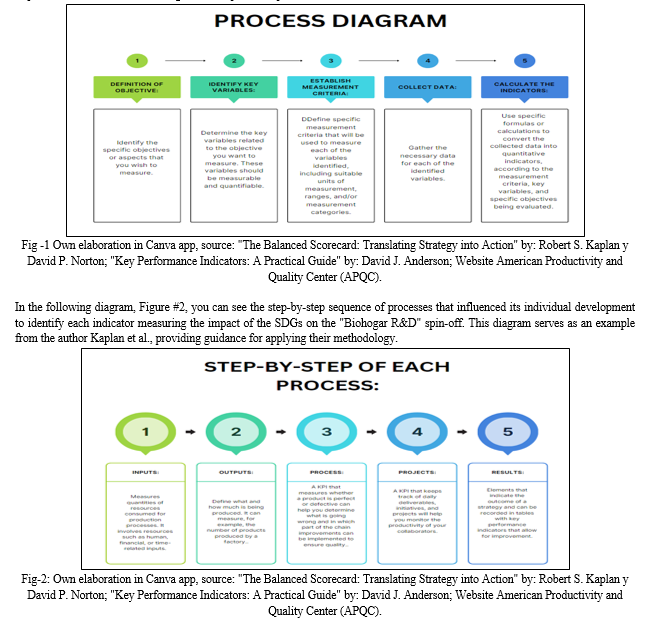
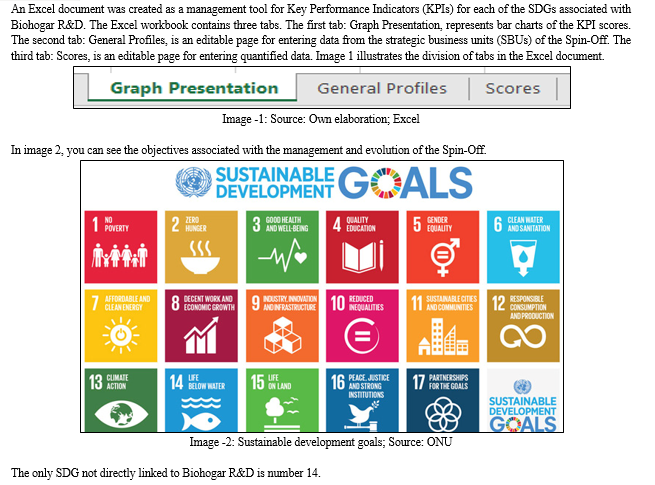
III. ANALYSIS AND RESULTS
Quantitative criteria for defining the measurement strategies of the impact that the sustainable development objectives have on the Biohogar R&D spin-off:
Next, the quantitative variables are chosen for each of the SDGs that directly impact Biohogar.


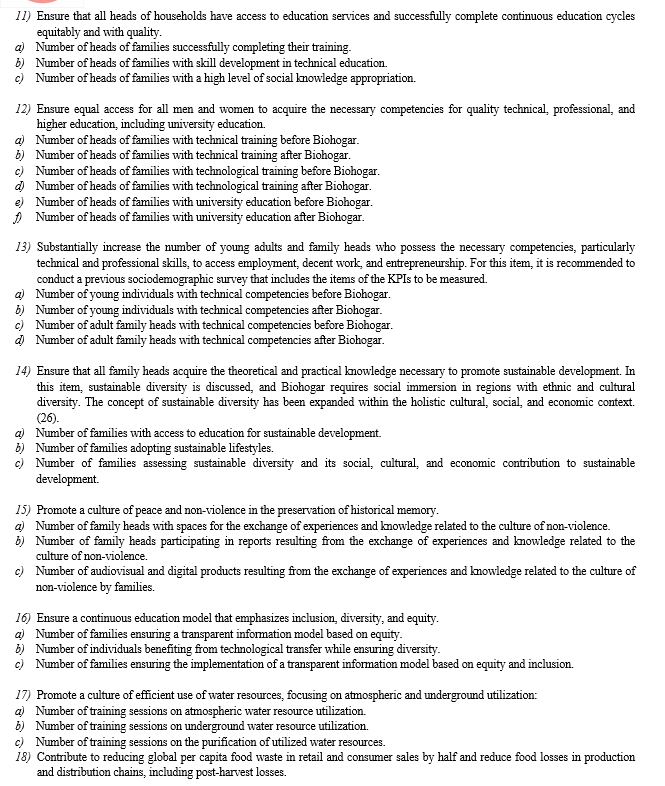
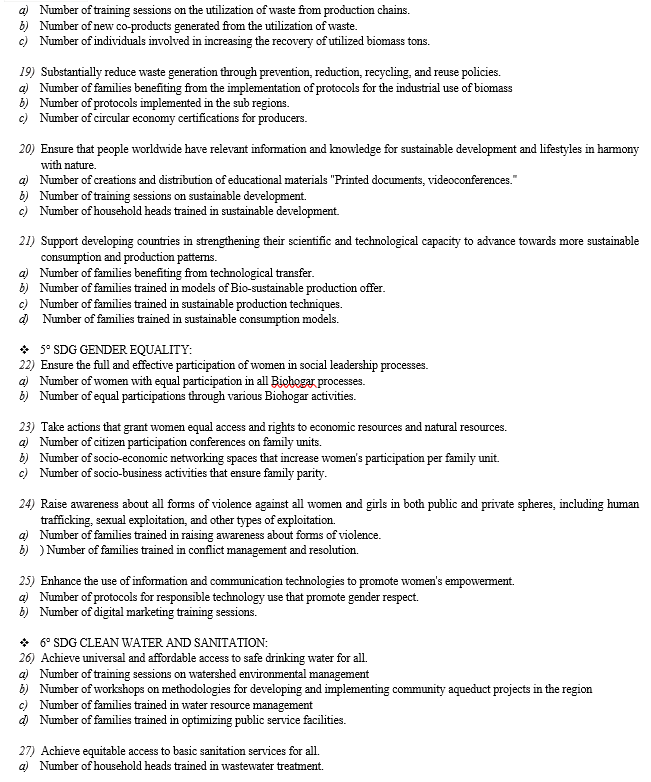

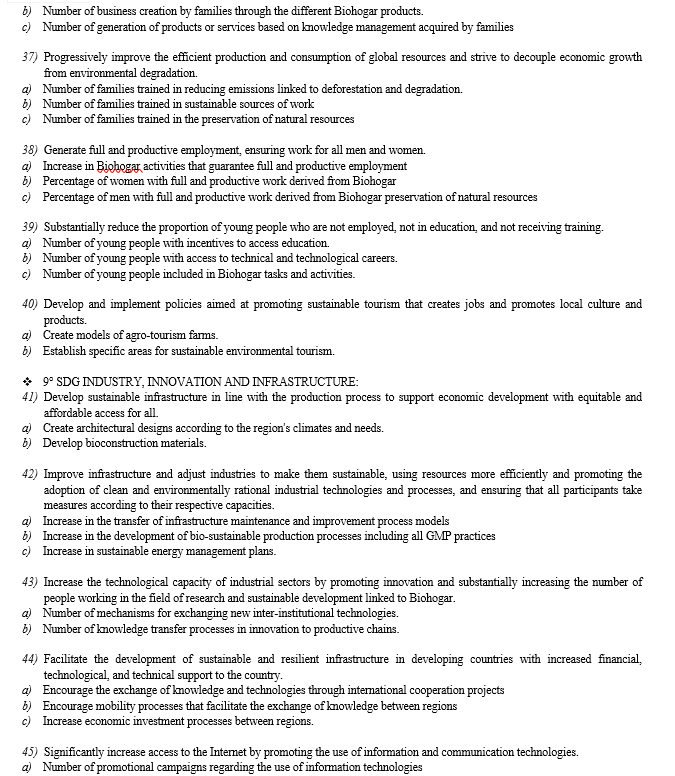
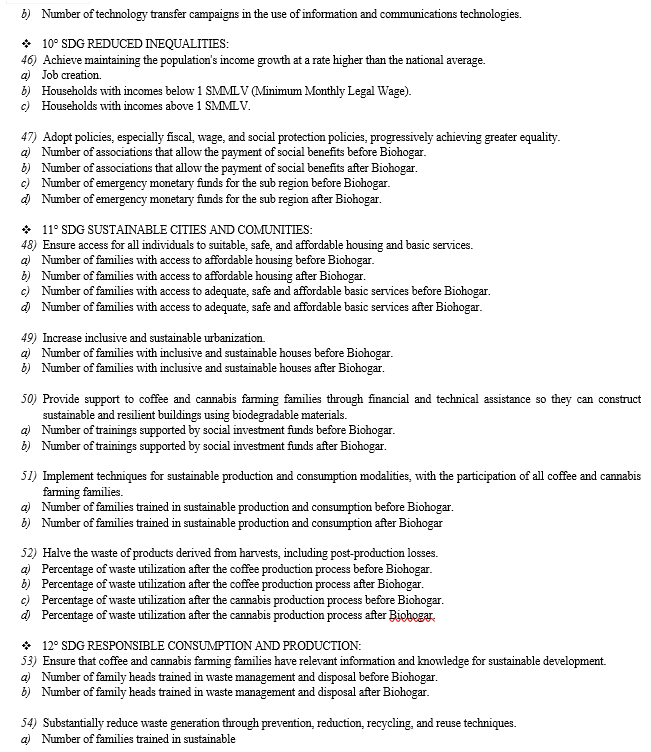
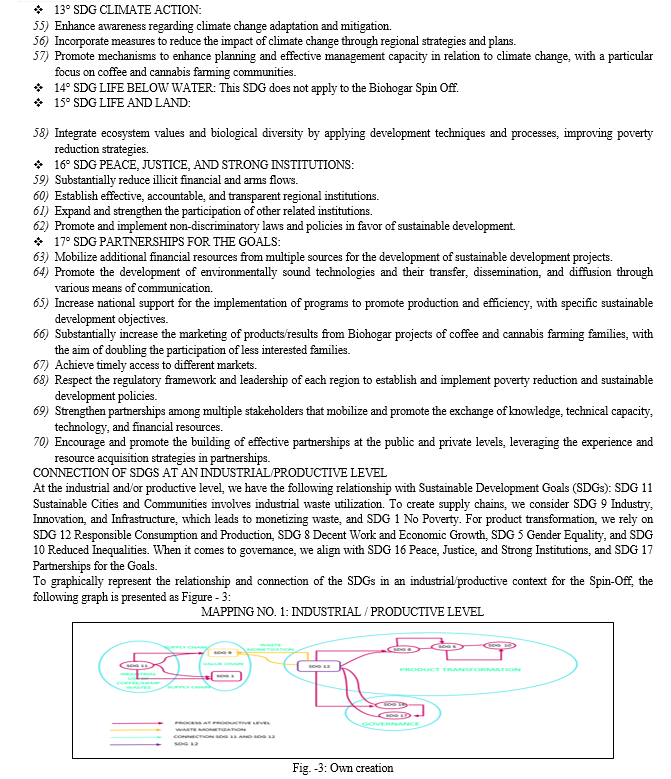

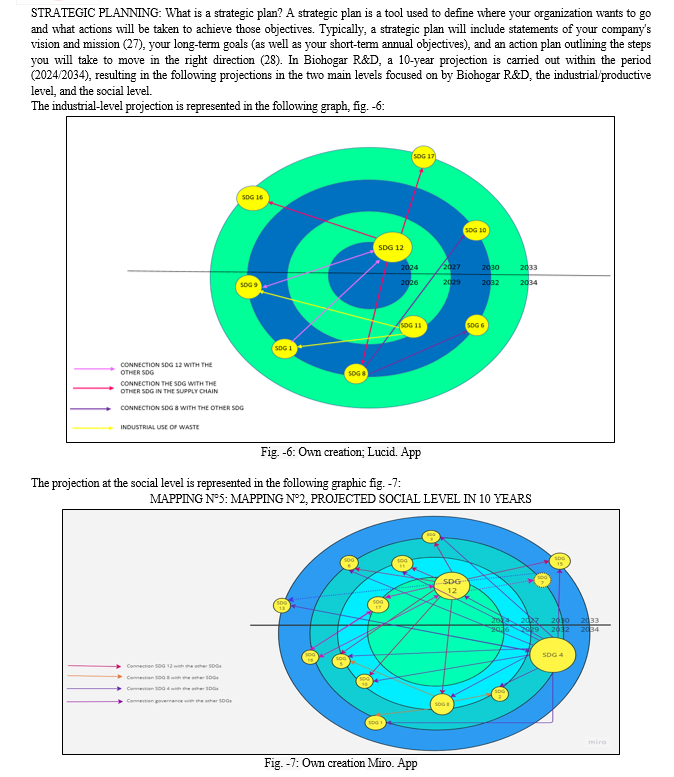

Conclusion
A strategic analysis was carried out to measure the impact of the Sustainable Development Goals on the “Biohogar R&D” Spin-Off, based on the future of the inter-institutional strategic alliance within the regions where the project will be developed. This mapping allowed us to project a vision of strategic planning integrated with the SDGs in a regional context; It was carried out by grouping the interactions between the SDGs, taking as reference a timeline with a 10-year projection for the levels (industrial/productive level and social level), which link to the Spin-Off. Likewise, the analysis and unification of the connection of the Sustainable Development Goals at the two levels involved was designed, demonstrating the impact of each of them on the specific areas and processes to be worked on. It was possible to see which SDGs are the most relevant and which could be addressed immediately, in the medium and long term. Management and performance indicators were defined, laying the foundations that will allow the “decision maker” to take action measures aimed at measuring, evaluating and adjusting activities both in the present and in the future, when required, said decisions should be correct. to focus on opportunities for improvement and achieve the goals established in the selection of criteria. The parameters used were based on a before and after the arrival of the company to the sub regions, a sample number of heads of family was set at 10 initially and 40 projected in a short time. A dashboard was designed for the KPIs associated with the SDGs, the quantitative parameters they have in the Spin-Off were associated. This prior diagnosis allowed us to obtain a real image of what happens inside and outside Biohogar R&D from a general point of view, the alignment between objectives and indicators carries representative and sufficient information to carry out the appropriate measurement of each of the 17 sustainable development goals.
References
[1] J. Gamarra Vergara; La economía del departamento del Cauca: concentración de tierras y pobreza; No. 95, octubre, 2007 [En línea]. Disponible https://www.banrep.gov.co/sites/default/files/publicaciones/archivos/DTSER-95.pdf [2] Gobernación del Cauca; Secretaria de agricultura y desarrollo rural; Plan Departamental de Extensión Agropecuaria 2020-2023, PDEA Ley 1876 de 2017; 2020 [En línea]. Disponible en: /https://www.minagricultura.gov.co/ministerio/direcciones/PublishingImages/Paginas/PDEA/Cauca.pdf [3] M. Ceballos Arévalo, Plan social del Cauca; Documento de formulación e implementación, Nov 2019 - abril 2020; 2019, p5. [En línea]. Disponible en: http://www.altocomisionadoparalapaz.gov.co/Documents/Plan-Social-del-Cauca-Formulacion-e-Implementacion-completo.pdf [4] L.M. Tejada Saa; CANNABIS MEDICINAL EN EL NORTE DEL CAUCA: ANÁLISIS SOBRE EL SURGIMIENTO DE LA COOPERATIVA POR LA UNIDAD NORTECAUCANA “CAUCANNABIS”; Trabajo de grado; Universidad ICESI; Santiago de Cali; 2020. [En línea]. Disponible en: https://repository.icesi.edu.co/biblioteca_digital/bitstream/10906/87367/1/TG02835.pdf [5] E. Calderón Trujillo; SISTEMATIZACIÓN DE EXPERIENCIA PROCESO DE SUSTITUCIÓN CULTIVOS ILÍCITOS DE CANNABIS, TORIBIO, CAUCA.”; Trabajo de grado; Universidad del Valle; Cali Colombia; 2020. [En línea]. Disponible en: https://bibliotecadigital.univalle.edu.co/bitstream/handle/10893/21638/Sistematizaci%C3%B3n%20de%20experiencia%20proceso.Edwin%20Calderon.pdf?sequence=1&isAllowed=y [6] G. Nuñez Torres; Café del Cauca, un privilegio que brota entre cielos claros y cordilleras; Diario la economía, Domingo, 25 octubre 2020. [En línea]. Disponible en: https://diariolaeconomia.com/tomemos-cafe/item/5721-cafe-del-cauca-un-privilegio-que-brota-entre-cielos-claros-y-cordilleras.html&sa=D&source=docs&ust=1689960522748053&usg=AOvVaw1p7HR7mE8hALNwOEFOLPk2 [7] Dirección de Investigaciones Económicas - Federación Nacional de Cafeteros de Colombia; Ensayo sobre economia cafetera; edición N°32; 2016-2017 [En línea]. Disponible en: a. https://federaciondecafeteros.org/static/files/Pobreza_vulnerabilidad_hogares_cafeteros.pdf [8] R. Vélez Vallejo; Informe del gerente 90 congreso nacional de cafeteros; Federación Nacional de Cafeteros de Colombia; 2022. [En línea]. Disponible en: https://federaciondecafeteros.org/app/uploads/2022/12/Informe-del-Gerente-D.pdf [9] N Rodríguez Valencia, D.A Zambrano Franco; LOS SUBPRODUCTOS DEL CAFÉ: FUENTE DE ENERGÍA RENOVABLE; Programa de Investigación Científica; Fondo Nacional del Café; ISSN - 0120 - 0178; CENICAFÉ; marzo de 2010. [En línea]. Disponible en: https://www.cenicafe.org/es/publications/avt0393.pdf&sa=D&source=docs&ust=1690218344433667&usg=AOvVaw2j7sIvLPmgQDwdu25rH7Mj [10] W. Urrego Yepes, M, J. Godoy Pernalete; Aprovechamiento de los residuos de la agroindustria del café en la elaboración de materiales compuestos de matriz polimérica; Revisión; PROSPECTIVA ISSN EN LÍNEA: 2216-1368- VOL 19, No 2; 2021. [En línea]. Disponible en: https://Dialnet-LaRevisionAprovechamientoDeLosResiduosDeLaAgroindu-7997615.pdf [11] L.M. Tejada Saa; CANNABIS MEDICINAL EN EL NORTE DEL CAUCA: ANÁLISIS SOBRE EL SURGIMIENTO DE LA COOPERATIVA POR LA UNIDAD NORTECAUCANA “CAUCANNABIS”; Trabajo de grado; Universidad ICESI; Santiago de Cali; 2020. [En línea]. Disponible en: https://repository.icesi.edu.co/biblioteca_digital/bitstream/10906/87367/1/TG02835.pdf [12] J. M. Ramírez; LA INDUSTRIA DEL CANNABIS MEDICINAL EN COLOMBIA; FEDESARROLLO; Bogotá, 2019. [En línea]. Disponible en: https://www.repository.fedesarrollo.org.co/bitstream/handle/11445/3823/Repor_Diciembre_2019_Ram%C3%ADrez.pdf?sequence=4&isAllowed=y [13] Centro de estudios regulatorios; MinCiencias, Decreto 1556 de 2022; [En línea]. Disponible en: https://www.cerlatam.com/normatividad/minciencias-decreto-1556-de-2022/ [14] Administrador; Cuidemos el planeta, Ecología y Medio Ambiente; ¿Qué es el desarrollo sostenible?, [En línea]. Disponible en: https://cuidemoselplaneta. org/desarrollo-sostenible/ [15] Cómo crear KPIs que lleven tu empresa al éxito; tableau from salesforce; [En línea]. Disponible en: https://www.tableau.com/es-mx/learn/articles/how-to-create-kpis#:~:text=Repasemos%3A%20los%20KPIs%2C%20siglas%20en,est%C3%A1s%20de%20tus%20objetivos%20empresariales. [16] UNODC; Métodos recomendados para la identificación y el análisis del cannabis y los productos del cannabis; Nueva York, 2010; [En línea]. Disponible en: https://www.unodc.org/documents/scientific/Cannabis_manual-Sp.pdf [17] UNODC; Métodos recomendados para la identificación y el análisis del cannabis y los productos del cannabis; Nueva York, 2010; [En línea]. Disponible en: https://www.unodc.org/documents/scientific/Cannabis_manual-Sp.pdf [18] Agencia Ambiental Francesa (ADEME, por sus siglas en francés); 2016 [19] A.F. Jiménez Vásquez; ATLAS DEL POTENCIAL TÉCNICO-ENERGÉTICO APROVECHABLE POR DIGESTIÓN ANAEROBIA DE LA BIOMASA RESIDUAL PECUARIA PARA LOS SUBSECTORES PORCÍCOLA Y GANADERÍA DE LECHE ESPECIALIZADA EN EL DEPARTAMENTO DE ANTIOQUIA”, Trabajo de grado; Universidad de Medellín, Medellín Colombia; 2020. [En línea]. Disponible en: https://repository.udem.edu.co/bitstream /handle/11407/6604/T_MIU_504.pdf?sequence=1&isAllowed=y [20] Global Bioeconomy Summit - GBS. 2018. Comuniqué. Global Bioeconomy Summit 2018 - Innovation in the Global Bioeconomy for Sustainable and Inclusive Transformation and Wellbeing; 2018 [En línea]. Disponible en: http://gbs2018.com/fileadmin/gbs2018/Downloads/GBS_2018_Communique.pdf [21] J. L. Morenilla Vicente y F. J. Martínez Gómez; MATERIALES PARA LA BIOCONSTRUCCIÓN; Editorial; Colegio Oficial de Aparejadores, área de Sostenibilidad y Medio Ambiente; [En línea]. Disponible en: https://www.riarte.es/bitstream/handle/20.500.12251/458/CERCHA%20108%20JUNIO-11.%20pp.%2068-73.%20Materiales%20para%20la%20bioconstrucci%c3%b3n.pdf?sequence=1&isAllowed=y [22] ONU MEDIO AMBIENTE; Taller Regional: Instrumentos para la implementación efectiva y coherente de la dimensión ambiental de la agenda de desarrollo. Caso 4: RESIDUOS; Ley N°8839 para la Gestión Integral de Residuos, Artículo 6 Definiciones; Costa Rica; 2010: [En línea]. Disponible en: https://www.cepal.org/sites/default/files/presentations/gestion_de_residuos_-_jordi_pon.pdf [23] Polimeni, R., Fabozzi, F., Adelbeg, A. & Kole, M. (1994). Contabilidad de Costos: Conceptos y Aplicaciones para la Toma de Decisiones Gerenciales (3ra. ed.). Santa Fe de Bogotá, Colombia: Mc Graw-Hill Interamericana. [En línea]. Disponible en: https://dspace.scz.ucb.edu .bo/dspace /bitstream/123456789/5751/1/14.pdf [24] C. A. Mejia; Publicación periódica coleccionable, Documento Planning n°1010; 2010; [En línea]. Disponible en: https://planning.com.co/bd /documentosPlanning/Octubre2010.pdf [25] J. Martins; Planificación estratégicas para empresas; Asana 03 de febrero 2023; [En línea]. Disponible en: https://asana.com/es/resources/strategic-planning [26] J. Barrera; S. Humbert; D. Rojas; M. Puerto; A. Gaitan B. PhD; N. Suppen; F. López Hernández; HUELLA AMBIENTAL DEL CAFÉ EN COLOMBIA DOCUMENTO GUÍA; Versión 1.0 [En línea]. Disponible en: https://www.andi.com.co/Uploads/HUELLA%20AMBIENTAL%20%20DEL%20CAF%C3%89%20EN%20COLOMBIA.pdf [27] J. Martins; Cómo redactar la visión de una empresa y ejemplos; Asana; 12 de septiembre de 2022; [En línea]. Disponible en: https://asana.com/es/resources/vision-statement [28] El Concurso Innovación para los Estilos de Vida Sostenible; Programa de Naciones Unidas para el Medio Ambiente (PNUMA) en colaboración con la Universidad de los Andes; 7 de Julio 2021; [En línea]. Disponible en: https://administracion.uniandes.edu.co/wp-content/uploads/archivos-drupal/archivos/2021/07/07/guia-tematica-estilos-de-vida-sostenible.pdf
Copyright
Copyright © 2023 Angie Gineth Daza Chavez, Richard Marcelo Imbachi Chavez. This is an open access article distributed under the Creative Commons Attribution License, which permits unrestricted use, distribution, and reproduction in any medium, provided the original work is properly cited.

Download Paper
Paper Id : IJRASET55798
Publish Date : 2023-09-20
ISSN : 2321-9653
Publisher Name : IJRASET
DOI Link : Click Here
 Submit Paper Online
Submit Paper Online

